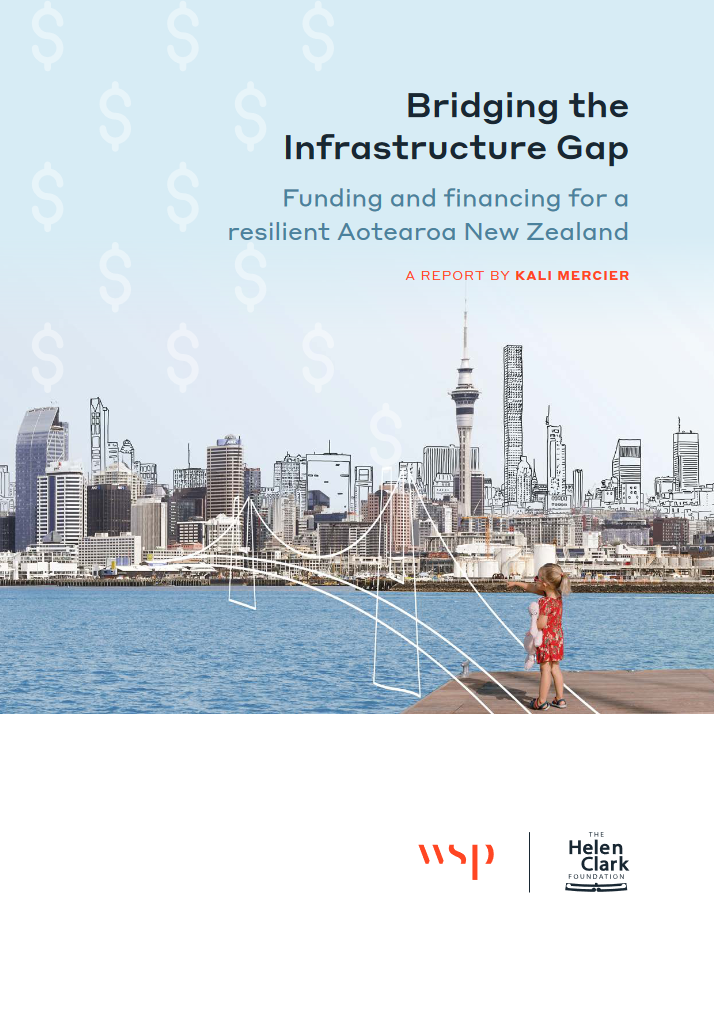Bridging the Infrastructure Gap: Funding and financing infrastructure for a resilient Aotearoa New Zealand is a research report released in partnership with WSP.
There is broad agreement that Aotearoa New Zealand faces a large shortfall in terms of the quantity of infrastructure the country needs, and the quality of what already exists. This report looks at the various ways we can fund and finance essential infrastructure, both to meet current needs, and to rise to emerging challenges such as climate change and a population that is both growing and aging rapidly, with much of this growth likely to happen in a small number of cities.
The report considers different funding and financing options, questions of intergenerational fairness, and decisions about how to spread costs fairly between current members of society. It concludes that the most efficient, straightforward, and transparent way to address the bulk of Aotearoa New Zealand’s long-term infrastructure deficit is likely to be long-term debt financing funded by appropriate taxation or rates, with taxation more able to be tailored more accurately to ability to pay. The report also considers the evidence behind Public-Private Partnerships, as well as city or regional deals that see central government awarding contracts to local government to address funding issues and support local initiatives.
Historically, Aotearoa New Zealand’s approach has been both to invest and underinvest in waves, with periods of significant investment followed by periods of underinvestment. The present situation sees many existing assets that have been ‘sweated’ to breaking point over the past decades, creating a significant infrastructure debt. The country must find common ground about how to pay for what it needs by developing a strategic, long-term vision, with – as far as this is possible – multi-party agreement. The goal should be to break the ‘boom-bust’ cycle and ensure consistent investment levels across terms of office. This will allow Aotearoa New Zealand to move ahead strategically and at pace to provide for its growing population.
Key report recommendations include:
- Seek agreement across political parties, to the extent possible, on a strategic long-term vision for the country’s infrastructure needs.
- Get more from infrastructure investment, including better value from procurement and delivery of infrastructure and focus on maintaining and optimising the use of infrastructure the country already has.
- Use a range of approaches to fund and finance infrastructure but recognise that the bulk of the country’s needs will continue to be financed by debt and serviced by taxation and/or rates.
- Identify opportunities to attach revenue sources to new infrastructure, particularly where this will lead to additional benefits.
- Ensure decisions around which funding and financing models are used consider questions of equity, efficiency, and effectiveness.
- With the proposed restart of the public-private partnership (PPP) programme in Aotearoa New Zealand, learn from experiences here and overseas to ensure the best application of this model.
- Trial city and regional deals, which can promote growth and enable investments in essential infrastructure projects that might otherwise go unfunded.
- Enable a greater level of resource transfer from central government to local government, to address chronic underinvestment in infrastructure (for example, by charging central government rates on their property, and/or by removing GST from rates).
You can see the press release about this report here.
Our new report, Built to Last, builds on some of the work done in this report. You can read the new report here.
Read more